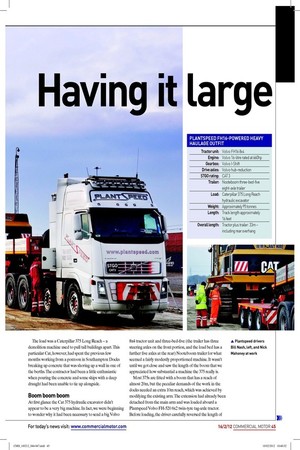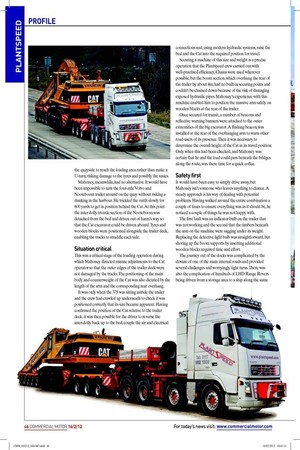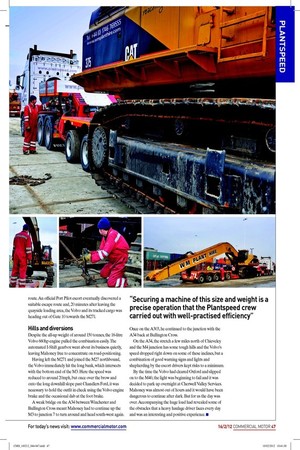Having it large
Page 40

Page 41

Page 42

If you've noticed an error in this article please click here to report it so we can fix it.
PLANTSPEED FH16-POWERED HEAVY HAULAGE OUTFIT Tractor unit: Volvo FH16 8x4 Engine: Volvo 16-litre rated at 660hp Gearbox: Volvo I-Shift Drive axles: Volvo hub-reduction STGO rating: CAT 3 Trailer: Nooteboom three-bed-five eight-axle trailer Load: Caterpillar 375 Long Reach hydraulic excavator Weight: Approximately 95 tonnes Length: Track length approximately 16 feet Overall length: Tractor plus trailer: 33m –
including rear overhang
The load was a Caterpillar 375 Long Reach – a demolition machine used to pull tall buildings apart. This particular Cat, however, had spent the previous few months working from a pontoon in Southampton Docks breaking up concrete that was shoring up a wall in one of the berths. The contractor had been a little enthusiastic when pouring the concrete and some ships with a deep draught had been unable to tie up alongside.
Boom boom boom
At irst glance the Cat 375 hydraulic excavator didn’t appear to be a very big machine. In fact, we were beginning to wonder why it had been necessary to send a big Volvo 8x4 tractor unit and three-bed-ive (the trailer has three steering axles on the front portion, and the load bed has a further ive axles at the rear) Nooteboom trailer for what seemed a fairly modestly proportioned machine. It wasn’t until we got close and saw the length of the boom that we appreciated how substantial a machine the 375 really is.
Most 375s are itted with a boom that has a reach of almost 20m, but the peculiar demands of the work in the docks needed an extra 10m reach, which was achieved by modifying the existing arm. The extension had already been detached from the main arm and was loaded aboard a Plantspeed Volvo FH-520 6x2 twin-tyre tag-axle tractor. Before loading, the driver carefully reversed the length of the quayside to reach the loading area rather than make a U-turn, risking damage to the tyres and possibly the susies.
Mahoney, meanwhile, had no alternative. It would have been impossible to turn the four-axle Volvo and Nooteboom trailer around on the quay without risking a dunking in the harbour. He trickled the outit slowly for 600 yards to get in position behind the Cat. At this point the inter dolly tri-axle section of the Nooteboom was detached from the bed and driven out of harm’s way so that the Cat excavator could be driven aboard. Tyres and wooden blocks were positioned alongside the trailer deck, enabling the tracks to straddle each side.
Situation critical
This was a critical stage of the loading operation during which Mahoney directed minute adjustments to the Cat operator so that the outer edges of the trailer deck were not damaged by the tracks. The positioning of the main body and counterweight of the Cat was also dictated by the length of the arm and the corresponding rear overhang.
It was only when the 375 was sitting astride the trailer and the crew had crawled up underneath to check it was positioned correctly that its size became apparent. Having conirmed the position of the Cat relative to the trailer deck, it was then possible for the driver to reverse the inter-dolly back up to the bed, couple the air and electrical connections and, using modern hydraulic systems, raise the bed and the Cat into the required position for travel.
Securing a machine of this size and weight is a precise operation that the Plantspeed crew carried out with well-practised eficiency. Chains were used wherever possible, but the boom section, which overhung the rear of the trailer by about 4m, had no built-in securing points and couldn’t be chained down because of the risk of damaging exposed hydraulic pipes. Mahoney’s experience with this machine enabled him to position the massive arm safely on wooden blocks at the rear of the trailer.
Once secured for transit, a number of beacons and relective warning banners were attached to the outer extremities of the big excavator. A lashing beacon was installed at the rear of the overhanging arm to warn other road-users of its presence. Then it was necessary to determine the overall height of the Cat in its travel position. Only when this had been checked, and Mahoney was certain that he and the load could pass beneath the bridges along the route, was there time for a quick coffee.
Safety first
It would have been easy to simply drive away, but Mahoney isn’t someone who leaves anything to chance. A steady approach is his way of dealing with potential problems. Having walked around the entire combination a couple of times to ensure everything was as it should be, he noticed a couple of things he was not happy with.
The irst fault was an indicator bulb on the trailer that was not working and the second that the timbers beneath the arm on the machine were sagging under its weight. Replacing the defective light bulb was straightforward, but shoring up the boom supports by inserting additional wooden blocks required time and effort.
The journey out of the docks was complicated by the closure of one of the main internal roads and provided several challenges and worryingly tight turns. There was also the complication of hundreds of LHD Range Rovers being driven from a storage area to a ship along the same route. An oficial Port Pilot escort eventually discovered a suitable escape route and, 20 minutes after leaving the quayside loading area, the Volvo and its tracked cargo was heading out of Gate 10 towards the M271.
Hills and diversions
Despite the all-up weight of around 150 tonnes, the 16-litre Volvo 660hp engine pulled the combination easily. The automated I-Shift gearbox went about its business quietly, leaving Mahoney free to concentrate on road-positioning.
Having left the M271 and joined the M27 northbound, the Volvo immediately hit the long bank, which intersects with the bottom end of the M3. Here the speed was reduced to around 20mph, but once over the brow and onto the long downhill slope past Chandlers Ford, it was necessary to hold the outit in check using the Volvo engine brake and the occasional dab at the foot brake.
A weak bridge on the A34 between Winchester and Bullington Cross meant Mahoney had to continue up the M3 to junction 7 to turn around and head south-west again. Once on the A303, he continued to the junction with the A34 back at Bullington Cross.
On the A34, the stretch a few miles north of Chieveley and the M4 junction has some tough hills and the Volvo’s speed dropped right down on some of these inclines, but a combination of good warning signs and lights and shepherding by the escort drivers kept risks to a minimum.
By the time the Volvo had cleared Oxford and slipped on to the M40, the light was beginning to fail and it was decided to park up overnight at Cherwell Valley Services. Mahoney was almost out of hours and it would have been dangerous to continue after dark. But for us the day was over. Accompanying the huge load had revealed some of the obstacles that a heavy haulage driver faces every day and was an interesting and positive experience. ■














































